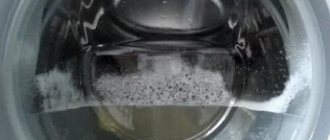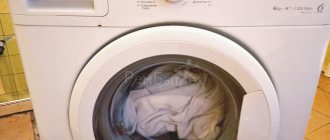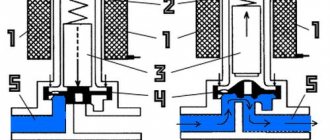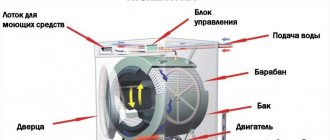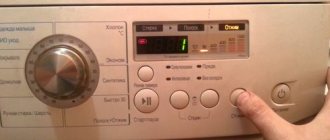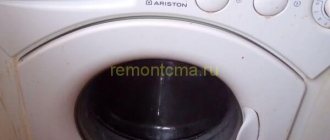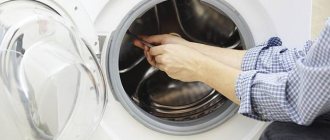"A-Iceberg" - 27 years with you. 5,700,000 repairs completed.
We will repair your washing machine at home in one visit. Original spare parts in stock.
Overflowing water in a washing machine is a typical problem that our technicians have to deal with. Note that modern automatic machines have overflow protection: if the water level in the drum reaches the maximum value, the drain pump will turn on and the excess liquid will drain into the sewer. Based on the nature of the malfunction, the device will either stop the program and display an error message, or continue washing, continuously drawing and draining water. But, despite the fact that the risk of leakage is minimal, you will not be able to use the device with such a problem. After all, even if the washing machine continues to wash, the excess water consumption will be enormous.
If there have been no problems with overflow before, unplug the device for 5-10 minutes, then turn it on again. If the problem persists, you will have to contact the Service Center. Most likely, the pressure switch or inlet valve is broken. Let's consider various types of malfunctions in which the automatic washing machine overflows water.
Water level sensor problem
According to statistics from our Service Center, in 9 out of 10 cases the cause of water overflow is precisely the failure of the pressure switch. The water level sensor measures the fullness of the tank and transmits the readings to the electronic module. Once the tank is filled with liquid to the required level, the pressure switch transmits a corresponding signal to the control board - the microprocessor sends a signal to close the filling valve. If the pressure switch breaks down, the machine will not be able to assess the existing water level in the tank and will begin to constantly dump or gain water, resulting in a shortage or overflow of liquid in the washing machine.
To restore the functionality of the washing machine, the broken sensor must be replaced with a new one. But the malfunction is not always associated with a broken part. The level switch is connected to the tank through a thin flexible hose and a compression chamber. The pressure switch will not work correctly if the tube has fallen off, become clogged or damaged, or the chamber has become clogged with scale and dirt. In these cases, the problem can be solved at minimal cost; it is enough to put on, blow out or replace the hose, or clean the chamber.
Major breakdowns associated with overflow
If you can't figure out why your washing machine is taking in a lot of water, check out the following reasons for the problem:
- The pressure switch tube is clogged, disconnected or damaged. In this case, the machine overflows water, then drains it and stops working. Depending on the cause of the breakdown, you will need to clean, replace or replace the tube.
- The water level sensor chamber is dirty. It can become clogged not only with dirt, but also with scale. Repairing a washing machine will involve dismantling and cleaning the device.
- The pressure switch itself broke. The problem can only be solved by replacing the part.
- The control module, which sends a signal to stop the flow of water, has failed. If the board cannot be repaired, it will need to be replaced.
- The fill valve is broken. With such a breakdown, the washing machine pours a lot of water immediately after starting washing or rinsing. Then the liquid is drained, but the SM does not turn off. She continues to work and continue to collect water. The unit can only be repaired by replacing the valve.
If the equipment overflows water, it needs to be repaired urgently. This should be done not because you risk flooding your neighbors. This risk is minimal if other components of the machine are in good working order. You will simply waste water and powder, which will immediately go down the drain at the very beginning of the wash. Therefore, do not use a broken SM and do not try to fix it yourself to avoid unnecessary complications. It’s better to call our service center and call a specialist to diagnose and repair washing machines.
Intake valve sticking
The fill valve is a special mechanism that regulates the water supply in an automatic washing machine. Its operating principle is as follows: based on a signal from the level sensor, the control board transmits a command to the filling valve, as a result of which voltage is supplied to the solenoid valve coil - an electromagnetic field is formed, under the influence of which the valve opens. Once the water level sensor informs the microprocessor that the machine has collected the required amount of liquid, the voltage supply will be interrupted and the valve will close. This happens when the unit is in good condition. But due to power surges, the valve may jam in the closed or open position. In this case, water will constantly flow into the tank, or vice versa, the device will not draw water at all. A broken valve cannot be repaired. It will need to be replaced.
What happens if the washing machine overflows water?
If the pressure switch does not work in time, the problem will manifest itself as follows:
- The washing machine will continue to fill the tank. There is a similar breakdown in which the SM simultaneously fills and drains the contents of the tank. That is, water does not linger inside the device. This is a completely different problem. When overflowing, the equipment fills with a lot of water, which can be seen through the glass of the hatch.
- The electronics will detect excess liquid inside the machine and give a command to remove it.
- The pump will start working. It will drain all the liquid down the drain. Even though the washer has previously collected a lot of water, only your clothes will remain in it.
- The washing will stop and an error message will appear.
The microprocessor control unit is faulty
The control board is the “brain” of the washing machine. It receives and processes signals coming from various actuators, including the pressure switch and inlet valve, and completely controls the washing. Voltage surges and water entering the electronic components of the device (the problem is typical for equipment installed in the bathroom) lead to breakdown of the control module. As a result of this, the machine begins to work incorrectly or does not turn on at all, and various problems are observed, including water overflow. Depending on the complexity of the breakdown, to eliminate the malfunction it is necessary to repair the control board or completely replace the control unit with a new one.
How dangerous is water overflow in a washing machine?
Many non-professionals who do not understand the structure of washing machines “scare” users with the dire consequences of overflowing. They say there is a high risk of flooding your neighbors or flooding the electronic control unit of the car itself. In fact, most modern washing machines have built-in overfill protection. As soon as the water level in the tank reaches a critical level, the overfill protection is triggered, the water is drained, and the device displays an error message. The risk of flooding your neighbors or damaging the electronic components of the device itself exists only in very old automatic machines, mostly domestically produced.
The reason why a washing machine overflows water, according to the experience of the RemBytTech workshop, most often lies in a breakdown. Only in rare cases can the problem be fixed on your own.
Washing machine repairman at home
If you find that your household appliance is constantly overflowing water, do not try to solve the problem yourself. Trying to repair it yourself can complicate the situation, contact a professional. Service offers inexpensive repair of washing machines in Moscow at home. We repair washing machines of all well-known brands, using original components that are always in stock, and professional tools. Qualified technicians will come to your home at the appointed time, carry out competent diagnostics and fix the problem in a short time, and provide a guarantee for the installed spare parts and services. To call a specialist, fill out the online form or call 8(495) 213-33-33
.
Is it possible to repair the SM yourself?
If the washing machine overflows water, the cause of the malfunction is not always equipment failure. Overflow may be associated with a failure of the control module due to voltage surges in the network. In this case, you can perform simple repairs yourself. To do this, you need to turn off the equipment (including from the outlet), wait a few minutes, turn it on again and try to start the device.
If the washer still overflows water, then the problem is related to a breakdown of one of the CM units. In this case, you need to turn off the washing mode and drain the liquid using the button on the unit. In case of serious malfunctions, the button may not work and you will have to use an emergency drain hose. After checking, you need to call a washing machine repairman.
Replacing the pressure switch
The level sensor is located on the tank at the rear of the machine. Therefore, to get to it, you will have to remove the cover of the unit. Next, the condition of the sensor contacts is visually assessed, and if there are traces of oxidation, mechanical cleaning is performed.
Self-replacement of the level sensor is carried out according to the following scheme:
- First, the hose going to the compression chamber is disconnected.
- Then, by unscrewing the two screws, remove the pressure switch from the housing, having previously disconnected the terminals of the device.
- We install the new sensor by tightening it with self-tapping screws.
- We connect the power terminals of the device.
- Connect the compression hose.
- We close the case with a protective cover.
Before closing the cover of the unit, you can perform a test run, on the basis of which the issue of serviceability of the system will be decided.
Incorrect operation of the control unit
A washing machine can constantly draw water if the control system, which is responsible for the proper functioning of all components of the unit, fails. In this case, the signals from the control board are sent in the wrong order, which can cause the tank to spontaneously fill with water.
In the event of such a breakdown, an error code is displayed on the control unit display, which allows you to navigate the cause of the malfunction. You can completely restart the control system by turning the unit off and on. If even after such manipulations the washing machine still constantly fills with water, then it is recommended to contact the specialists of the repair center. A malfunction of the control unit is a very big problem, since most often it is necessary to completely change the control board.
Sewer blockage
Also, the washing machine constantly draws water if the general sewer is clogged. This siphon effect occurs as a result of the appearance of rarefied pressure when neighbors in the riser use the sewer. This pressure is sufficient for periodic pumping of liquid from the tank of the washing unit.
Installing a special low-power valve (anti-siphon) on the drain hose allows you to get rid of this harmful circumstance.
A temporary preventative measure is to disconnect the drain from the siphon and install it in the bathtub or sink when washing.
What are the causes of water overflow
A large amount of water in the drum may not always be a sign of a malfunction of some machine parts. For example:
- Some Ariston units have a built-in “Anti-shock” function, which is triggered when the temperature regime is violated before draining the water (for example, spinning or rinsing).
- The system of protection against excessive foam formation is triggered, as on many models of Ardo machines.
- More water is drawn into the tank in the “Delicate Wash” mode - this is done on LG washing machines.
But these are isolated cases, and at the moment we are talking about systematic overflows of water during washing. The main reasons for the washing machine to collect a large amount of water are as follows.
Reasons for uncontrolled water intake
It is not difficult to notice that the Ariston washing machine constantly fills with water. After collection, the water is constantly drained into the sewer, which is accompanied by the incessant noise of the liquid being removed, and also greatly lengthens the process of washing clothes.
The most common reasons why a washing machine constantly fills with water are:
- Incorrect connection of the washing machine during installation.
- Damage to the filler (inlet) or outlet valve.
- Malfunction of the liquid level sensor (pressostat).
- Failure in the electronic control system.
The water drains itself
This problem can occur even if the machine is connected correctly. This can happen because the pressure level in the sewer system is very low. And the water is simply drawn in there, leaving the washing machine tank. To solve this problem, we recommend purchasing an anti-drain valve (“anti-drain”) and placing it in the hose gap. With its help, you will save the machine from such draining of water.
Plumbing problems
If water is poured in very slowly or not at all, then it is worth checking its presence and pressure in the water pipe. To do this, simply open the kitchen faucet (or bathroom faucet). Accordingly, if you see that the water is not flowing, then the problem is that someone turned it off. And if it flows, but barely, it means the pressure is low. And for this reason, water can fill the tank very slowly. To resolve this issue, we advise you to contact the Housing Office. They may already know that your home has this problem. In this case, they will inform you when it will be eliminated. Or they don't even know what happened. In this case, they need to be informed so that they can take up the matter.
It is also worth checking the tap that blocks the access of water to the machine. It may not be fully open or even closed. If your problem is that the water does not fill, then you can also read this article: The washing machine does not fill with water.

